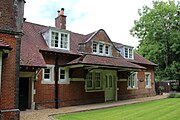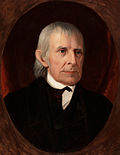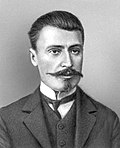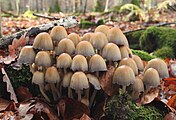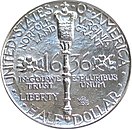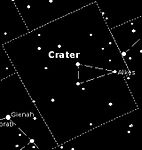Wikipedia:Today's featured article/June 2019
| << | Today's featured articles for June 2019 | >> | ||||
|---|---|---|---|---|---|---|
| Su | Mo | Tu | We | Th | Fr | Sa |
| 1 | ||||||
| 2 | 3 | 4 | 5 | 6 | 7 | 8 |
| 9 | 10 | 11 | 12 | 13 | 14 | 15 |
| 16 | 17 | 18 | 19 | 20 | 21 | 22 |
| 23 | 24 | 25 | 26 | 27 | 28 | 29 |
| 30 | ||||||
June 1
Cleopatra (69–30 BC) was the last active ruler of the Ptolemaic Kingdom of Egypt, though nominally survived as pharaoh by her son Caesarion. As a member of the Ptolemaic dynasty, she was a descendant of its founder Ptolemy I Soter, a Macedonian Greek general and companion of Alexander the Great. After the death of Cleopatra, Egypt became a province of the Roman Empire, marking the end of the Hellenistic period that had lasted since the reign of Alexander (336–323 BC). While her native language was Koine Greek, she was the first Ptolemaic ruler to learn the Egyptian language. Cleopatra's legacy survives in numerous works of art. She has been a pop culture icon of Egyptomania since the Victorian era, appearing in burlesque satire, Hollywood films such as Cleopatra (1963), and commercial brands. (Full article...)
Part of the Cleopatra featured topic.
June 2
Gioachino Rossini (1792–1868) was an Italian composer known for his 39 operas, although he also wrote many songs, some chamber music and piano pieces, and some sacred music. In the period 1810–1823 he wrote his most popular works including the comic operas L'italiana in Algeri, Il barbiere di Siviglia (The Barber of Seville) and La Cenerentola, building on the traditions of masters such as Domenico Cimarosa. He also composed opera seria works such as Otello, Tancredi and Semiramide. All of these show innovation in melody, harmonic and instrumental colour, and dramatic form. In 1824 he was contracted by the Opéra in Paris, for which he produced an opera to celebrate the coronation of Charles X, Il viaggio a Reims, later cannibalized for Le comte Ory, and in 1829 his last opera, Guillaume Tell (William Tell). He retired from large-scale composition while still in his thirties, at the height of his popularity. (Full article...)
June 3
The 24 Kaiman-class ships were high-seas torpedo boats built for the Austro-Hungarian Navy between 1904 and 1910. Yarrow Shipbuilders built the lead ship (launched on 3 June 1905), Stabilimento Tecnico Triestino of Trieste built 13 boats, and Ganz-Danubius constructed the remaining 10 boats at their shipyards at Fiume. The class was considered to be a very successful design, and all boats saw extensive active service during World War I, undertaking a range of tasks, including escort duties, shore bombardments and minesweeping. All survived, although several were damaged by naval mines and collisions. One was torpedoed and badly damaged by a French submarine, and two sank an Italian submarine. All the boats were transferred to the Allies and scrapped at the end of the war, except for four that were allocated to the navy of the newly created Kingdom of Serbs, Croats and Slovenes. These were discarded and broken up between 1928 and 1930. (Full article...)
June 4
Droxford railway station was a rural station on the Meon Valley Railway in Hampshire, England. In 1944 it was used by Winston Churchill during preparations for the Normandy landings. Based in an armoured train parked in its sidings, he met with numerous ministers, military commanders and leaders of allied nations. On 4 June 1944, shortly before the landings were due to take place, Free French leader Charles de Gaulle visited Churchill at Droxford, and was informed of the invasion plans. Churchill told de Gaulle that if ever forced to choose between France and the US he would always side with the US, a remark which instilled in de Gaulle a suspicion of Britain and caused long-term damage to the relationship between France and the UK. In 1955 the station closed to passengers and in 1962 to goods, after which the station and a section of its track were used for demonstrating an experimental railbus and as a driving school, before becoming a private residence. (Full article...)
June 5
The black mamba (Dendroaspis polylepis) is a species of extremely venomous snake native to parts of Sub-Saharan Africa. It is the second-longest venomous snake after the king cobra; mature specimens generally exceed 2 metres (6.6 feet) and commonly grow to 3 m (10 ft). Specimens of 4.3 to 4.5 m (14.1 to 14.8 ft) have been reported. Its skin colour varies from grey to dark brown. The species is both terrestrial (ground-living) and arboreal; it inhabits savannah, woodland, rocky slopes and, in some regions, dense forest. It is diurnal and is known to prey on birds and small mammals. Over suitable surfaces, it can move at speeds up to 16 km/h (10 mph) for short distances. It is capable of striking at considerable range and may deliver a series of bites in rapid succession. Its venom, primarily composed of neurotoxins, is frequently fatal unless antivenom is administered. Despite its reputation as a formidable and highly aggressive species, the black mamba rarely attacks humans. (Full article...)
June 6
Smythe's Megalith was a chambered long barrow near the village of Aylesford in the south-eastern English county of Kent. Probably constructed in the fourth millennium BCE, during Britain's Early Neolithic period, it was discovered in 1822, at which point it was dismantled. Built out of earth and at least five local sarsen megaliths, the long barrow consisted of a roughly rectangular earthen tumulus with a stone chamber in its eastern end. Archaeologists have established that the monument was built by pastoralist communities shortly after the introduction of agriculture to Britain from continental Europe. Part of an architectural tradition of long barrows that was widespread across Neolithic Europe, Smythe's Megalith belonged to a regional variant produced near the River Medway, now known as the Medway Megaliths. Several of these still survive: Coldrum Long Barrow, Addington Long Barrow, Chestnuts Long Barrow, Kit's Coty House, the Little Kit's Coty House, and the Coffin Stone. (Full article...)
June 7
The history of aluminium in human usage goes back at least 2,500 years, when its compound alum was used for dyeing and fire-resistant coating. During the Middle Ages, alum was traded in international commerce. In the Age of Enlightenment, the earth of alum, alumina, was shown to be an oxide of a new metal which was then discovered in the 1820s. Pure aluminium remained scarce until industrial production began in 1856; since the 1886 discovery of the Hall–Héroult process, production has grown exponentially. Engineering and construction applications began in the first half of the 20th century; aluminium was a vital strategic resource for aviation during both world wars. In 1954, it surpassed copper as the most produced non-ferrous metal. In the following decades, aluminium production spread throughout the world, and the metal became an exchange commodity and gained usage in transportation and packaging. Aluminium production in the 21st century exceeds that of all other non-ferrous metals combined. (Full article...)
June 8
Kim Clijsters (born 8 June 1983) is a Belgian tennis player who competed professionally from 1997 to 2012. A former world No. 1 in both singles and doubles, she won four Grand Slam singles titles, including three US Open championships. Together with Justine Henin, she established Belgium as a force in women's tennis, leading their country to its first Fed Cup crown in 2001. Clijsters won forty-one Women's Tennis Association (WTA) singles titles, including three WTA Tour Championships. After retiring at the age of 23, Clijsters returned to tennis and won a record-tying three Grand Slam singles titles as a mother on the way to becoming the only mother to be ranked No. 1 in singles by the WTA. She was known for her athleticism, in particular her ability to perform splits on court in the middle of points. Clijsters won the Karen Krantzcke Sportsmanship Award eight times. She was inducted into the International Tennis Hall of Fame in 2017. (Full article...)
June 9
Round the Horne is a British radio comedy show, first broadcast by the BBC in four series of weekly shows between 1965 and 1968, and frequently repeated since then. The programme was created by the writers Barry Took and Marty Feldman (pictured), and stars Kenneth Horne, with a supporting cast of Kenneth Williams, Hugh Paddick, Betty Marsden and, in the first three series, Bill Pertwee. Horne plays a benign central figure surrounded by a gallery of larger-than-life characters including the camp pair Julian and Sandy, the disreputable eccentric J. Peasmold Gruntfuttock, and the singer of dubious folk songs, Rambling Syd Rumpo, who all became nationally familiar throughout the UK. The show was much criticised by morality campaigners for its irreverence and double entendres, but attracted an unusually large audience at the time, and in a 2019 poll was voted the BBC's third-best radio show of any genre, and the best British radio comedy series of all. (Full article...)
June 10

Mukhtar al-Thaqafi (c. 622 – 687) was an early Islamic revolutionary based in Kufa who led a rebellion against the Umayyads during the Second Islamic Civil War and ruled over most of Iraq for eighteen months. Mukhtar had allied with the Mecca-based rival caliph Abd Allah ibn al-Zubayr following Husayn ibn Ali's death at the Battle of Karbala, but returned to Kufa after caliph Yazid's death. He declared Muhammad ibn al-Hanafiyyah, a son of Ali, to be the Mahdi, and took power in his name in 685. Hostile relations with Ibn al-Zubayr ultimately led to Mukhtar's death at the hands of the Zubayrid governor of Basra, Mus'ab ibn al-Zubayr, following a four-month siege. Mukhtar's followers formed a radical Shia sect; later called Kaysanites, they developed novel doctrines and played a significant role in the Abbasid Revolution. Mukhtar is a controversial figure among Muslims, revered by Shia but condemned by many others as a false prophet. (Full article...)
June 11
Cyclone Raja was a severe tropical cyclone that spawned in the South Pacific in December 1986. It holds the 24-hour rainfall record of 674.9 mm (26.57 in) for the French Overseas Territory of Wallis and Futuna. After it was named on 23 December, it unexpectedly headed southeast toward Futuna. The system peaked at Category 3 on 28 December, with sustained winds of around 150 km/h (90 mph). It turned southwest the next day, toward Fiji and several smaller islands in the Lau group. The storm dissipated on 5 January over the north Tasman Sea. Raja caused two deaths as it impacted the island nations of Tuvalu, Wallis and Futuna, Tonga and Fiji. Gusty winds and rough seas caused extensive damage to crops, coastal installations and buildings in Tuvalu, and greater destruction in Futuna. Raja was responsible for the worst flood of the Labasa River in Fiji since 1929. The name Raja was later retired from the South Pacific naming lists. (Full article...)
June 12
RSPB Dearne Valley Old Moor is an 89-hectare (220-acre) wetlands nature reserve in the Dearne Valley near Barnsley, South Yorkshire, run by the Royal Society for the Protection of Birds (RSPB). It lies on the junction of the A633 and A6195 roads and is bordered by the Trans Pennine Trail long-distance path. Old Moor is managed to benefit bitterns, breeding waders such as lapwings, redshanks and avocets, and wintering golden plovers. Passerine birds include a small colony of tree sparrows and good numbers of willow tits, thriving despite a steep decline elsewhere in the UK. The reserve, along with others nearby, forms part of a landscape-scale project to create wildlife habitat in the Dearne Valley. As of 2018, the reserve had about 100,000 visits per year. It may benefit from future habitat creation beyond the reserve and improved accessibility, although there is also a potential threat from climate change and flooding. (Full article...)
June 13
Newberry Volcano is a large shield-shaped stratovolcano located 35 miles (56 km) east of the major crest of the Cascade Range and about 20 miles (32 km) south of Bend, Oregon, within the Newberry National Volcanic Monument. Considered an active volcano, it is closely monitored with sensors by the United States Geological Survey. Newberry is the largest volcano in the Cascade Volcanic Arc, with a total volume of approximately 120 cubic miles (500 km3) and a caldera (pictured) 4 by 5 miles (6.4 km × 8.0 km) in diameter. It was named for the geologist and surgeon John Strong Newberry, who explored central Oregon for the Pacific Railroad Surveys in 1855. The surrounding area has been inhabited by Native American populations for more than 10,000 years. The volcano and its vicinity include many pyroclastic cones, lava flows, and lava domes, with more than 400 vents, the most of any volcano in the contiguous United States. Newberry Volcano is a popular destination for recreational activities. (Full article...)
June 14
"Ice" is the eighth episode of the first season of the American science fiction television series The X-Files. Premiering on the Fox network on November 5, 1993, "Ice" was directed by David Nutter (pictured) and written by Glen Morgan and James Wong. The debut was watched by 10 million viewers in 6.2 million households and received largely positive reviews from critics, who praised its tense atmosphere. In the episode, FBI special agents Fox Mulder (David Duchovny) and Dana Scully (Gillian Anderson) investigate the deaths of an isolated Alaskan research team. The agents and their team discover the existence of extraterrestrial parasitic organisms which drive their hosts into impulsive fits of rage. The episode was inspired by an article in Science News about an excavation in Greenland, and series creator Chris Carter also cited John W. Campbell's 1938 novella Who Goes There? as an influence. (Full article...)
June 15
Adam Eckfeldt (June 15, 1769 – February 6, 1852) was the second chief coiner of the United States Mint. His father owned a large smithy and involved himself in early attempts at American coinage. Eckfeldt built early presses for the Mint, engraved some of its early dies, and was responsible for some designs of early American copper pieces, as well as the 1792 half disme, which some authorities consider the first United States coin. He was appointed assistant coiner of the Mint in 1796, and became chief coiner after his predecessor's death in 1814. During Eckfeldt's tenure, the Philadelphia Mint moved to new premises and expanded its operations. Setting aside unusual coins that were brought in as bullion, he started the Mint's coin cabinet, which evolved into the National Numismatic Collection. Despite his 1839 retirement, Eckfeldt continued performing the duties of chief coiner until his death, though his successor, Franklin Peale, bore the title. (Full article...)
June 16
Gallimimus was a theropod dinosaur that lived in what is now Mongolia about 70 million years ago, during the Late Cretaceous. The genus is part of the ostrich dinosaur group of feather-bearing, fast runners. Its head was small and light with large eyes and a bulbous structure at the base of the skull. The snout was longer, broader and more rounded than in similar species. Its horny beak was toothless with a delicate lower jaw. The neck and legs were long, and the weak forelimbs had short three-fingered hands. Several of its fossils were discovered in the Gobi Desert in the 1960s. Gallimimus means "chicken mimic", from the shape of its neck vertebrae. It may have had good vision and intelligence comparable to ratite birds, living in groups as an omnivore, a filter-feeder or a herbivore. Gallimimus was featured in the film Jurassic Park in a scene that included innovative special effects and shaped the popular view of these dinosaurs as bird-like animals. (Full article...)
June 17
North-Eastern Area Command was one of several geographically based commands raised by the Royal Australian Air Force (RAAF) during World War II. It was formed in January 1942 and controlled units in central and northern Queensland, and Papua New Guinea. Headquartered at Townsville, Queensland, North-Eastern Area Command's responsibilities included air defence, aerial reconnaissance and protection of the sea lanes within its boundaries. Its flying units, equipped with fighters, reconnaissance bombers, dive bombers and transports, took part in the battles of Rabaul, Port Moresby and Milne Bay in 1942, and the landings at Hollandia and Aitape in 1944. The area command continued to operate after the war, but its assets and staffing were much reduced. Its responsibilities were subsumed in February 1954 by the RAAF's new functional commands: Home (operational), Training, and Maintenance Commands. The area headquarters was disbanded in December 1956 and re-formed as Headquarters RAAF Townsville. (Full article...)
June 18
The Astronomica is a Latin didactic poem about celestial phenomena, written in hexameters and divided into five books. It was written c. AD 10–20 by a Roman poet whose name was likely Marcus Manilius. The earliest work on astrology that is extensive, comprehensible, and mostly intact, the poem focuses heavily on the zodiac. It espouses a Stoic, deterministic understanding of a universe overseen by a god and governed by reason. It was rediscovered in the 15th century by the Italian humanist and scholar Poggio Bracciolini, who had a copy made from which the modern text derives. The Astronomica was read, commented upon, and edited by scholars, but then was neglected for centuries. This started to change during the early 20th century when the classicist A. E. Housman published a critically acclaimed edition of the poem. Housman's work was followed by the Latinist G. P. Goold's lauded English translation in 1977. (Full article...)
June 19
Knight Lore is a 1984 action-adventure game that popularised isometric graphics in video games. It was developed and published for the ZX Spectrum by Ultimate Play the Game and written by Chris and Tim Stamper (pictured). Each monochrome castle room consists of blocks to climb, obstacles to avoid, and puzzles to solve. The game's novel image masking technique, Filmation, let images appear to pass atop and behind each other without distortion. By delaying the release until 1984, Ultimate was able to release several titles quickly before other developers could copy the style. Critics considered its technical solutions and isometric 3D style a harbinger of future game design. They praised the game's controls and atmosphere of mystery, but noted its difficult gameplay and criticised its sound and occasional graphical slowdown. It was named game of the year by the Golden Joystick Awards and Popular Computing Weekly readers. Though it was not the first isometric 3D video game, Knight Lore popularised the format; its influence also persisted in computer role-playing games. The game was later included in Rare's 2015 Xbox One retrospective compilation, Rare Replay. (Full article...)
June 20
The echo parakeet (Psittacula eques) is a species of parrot endemic to the Mascarene Islands of Mauritius and formerly Réunion. It is the only living native parrot of these islands; all others have become extinct due to human activity, including the subspecies P. e. eques, the Réunion parakeet. The echo parakeet is 34–42 cm (13–17 in) long and weighs 167–193 g (5.9–6.8 oz), with a wing-span of 49–54 cm (19–21 in). It is generally green; the male has one black and one pink collar, and the female has one green and one black. It is largely restricted to the canopy of the Black River Gorges National Park in the south west of Mauritius, feeding mainly on the fruits and leaves of native plants. Due to destruction and alteration of its native habitat, its numbers declined throughout the 20th century, reaching as few as 8–12 in the 1980s, when it was referred to as "the world's rarest parrot". While it is still endangered, an intensive effort of captive breeding has prevented its extinction. (Full article...)
June 21
Irakli Tsereteli (1881–1959) was a Georgian politician and Menshevik during the Russian Revolution. He was born and raised in Georgia when it was part of the Russian Empire. A member of the Russian Social Democratic Labour Party, Tsereteli was elected to the Duma in 1907, but was soon charged with conspiracy to overthrow the Tsarist government and exiled to Siberia. After the 1917 February Revolution, he took a position in the Russian Provisional Government as Minister of Post and Telegraph, and briefly as Minister of the Interior. After the Bolsheviks seized power during the October Revolution, Tsereteli returned to Georgia. At the Paris Peace Conference he lobbied for international recognition and assistance for the newly independent Democratic Republic of Georgia; these efforts largely failed before the Bolshevik-led Red Army invaded in 1921. He spent the rest of his life in exile, working with socialist organisations and writing on socialism, and died in New York. (Full article...)
June 22
SOLRAD 1 was a science and surveillance satellite launched into orbit on June 22, 1960. Developed by the US Naval Research Laboratory, it was the first satellite to successfully observe solar X-rays, the first to conduct surveillance from orbit, and the first to be launched with another instrumented satellite (the unrelated navigation satellite, Transit 2A). The scientific mission was a success, sending data that determined normal solar X-ray output and confirmed the connection between increased solar X-ray activity and radio fade-outs. The Galactic Radiation and Background electronic surveillance package on board had a covert mission: mapping the Soviet Union's air defense radar network. This mission was also successful, operating through September 22, 1960, and revealing that the network was more extensive than had been expected. SOLRAD 1 was switched off in April 1961, making it the first satellite to be remotely deactivated. (Full article...)
June 23
Christgau's Record Guide: Rock Albums of the Seventies is a music reference book by American music journalist and essayist Robert Christgau (pictured). It was first published in October 1981 by Ticknor & Fields. Covering a variety of genres with a focus on rock music, the book compiles approximately 3,000 capsule album reviews, most of which were originally written for his "Consumer Guide" column in The Village Voice throughout the 1970s. Many of the older reviews were rewritten for the guide to reflect his matured perspective and style, informed by an interest in the aesthetic and political dimensions of popular music and a desire to communicate his ideas to readers in an entertaining, provocative way. The guide was critically well received, with praise given for its extensive discography, Christgau's judgment, and colorful writing. A staple of rock-era reference works, it became a source for popular music studies and a guide for fellow critics, record collectors, and music shops. (Full article...)
June 24
Shergar (1978–1983) was an Irish-bred, British-trained Thoroughbred racehorse. In 1981 Shergar ran in six races, winning five of them. In June that year he won the 202nd Epsom Derby by ten lengths—the longest winning margin in the race's history. Three weeks later he won the Irish Sweeps Derby by four lengths; a month after that he won the King George VI and Queen Elizabeth Stakes by four lengths. He was retired to the Ballymany Stud in County Kildare, Ireland, but was stolen by an armed gang in February 1983. In 1999 Sean O'Callaghan, a former member of the Provisional Irish Republican Army, published details of the theft and said it was an operation to raise money for arms. An investigation by The Sunday Telegraph concluded that the horse was shot four days after the theft. No arrests were made for the theft, and Shergar's body was never recovered. In his honour the Shergar Cup was inaugurated in 1999. (Full article...)
June 25
Raymond Leane (1878–1962) was an Australian Army brigadier general. Twice decorated for gallantry, he was wounded three times during the Gallipoli campaign of World War I, and temporarily commanded the 11th Battalion there before the Australian force was withdrawn to Egypt. Leane led the 48th Battalion in fighting on the Western Front from 1916 to 1918 before commanding the 12th Brigade during the last part of the war. He was described by the Australian Official War Historian, Charles Bean, as "the foremost fighting leader" in the Australian Imperial Force. Leane was also called "the head of the most famous family of soldiers in Australian history", as four of his brothers and six of his nephews served in World War I, with two of each being killed. After the war, he served as Commissioner of the South Australia Police from 1920 to 1944, for which he was knighted in 1945. (Full article...)
June 26
A bank robbery was committed by Bolsheviks on 26 June 1907 in the city of Tiflis, Russian Empire, what is now Georgia's capital, Tbilisi. Planned by Vladimir Lenin, Joseph Stalin, Maxim Litvinov, Leonid Krasin, and Alexander Bogdanov, it was carried out by revolutionaries led by Stalin's early associate Kamo. The attack killed forty people and injured fifty others; the robbers escaped with 341,000 rubles. The Bolsheviks were unable to use most of the large banknotes they had stolen because the serial numbers were known to the police. Lenin thought of a plan to have the notes cashed simultaneously throughout Europe, but this strategy failed. Kamo was imprisoned for this and other crimes, but was released after the Russian Revolution; no other major conspirator was ever tried. After his death, Kamo was buried under a monument constructed near the robbery site, but the grave and monument have since been removed. (Full article...)
June 27
Coprinellus micaceus is a common species of fungus in the family Psathyrellaceae with a cosmopolitan distribution. The species typically grows in dense clusters on or near rotting hardwood tree stumps or underground tree roots. Depending on their stage of development, the tawny-brown mushroom caps may range in shape from oval to bell-shaped to convex, and reach diameters up to 3 cm (1.2 in). In young specimens, the cap surface is coated with a fine layer of reflective mica-like cells, inspiring the species name as well as the common names "mica cap", "shiny cap", and "glistening inky cap". A few hours after collection, the gills will start to dissolve into a black, inky, spore-laden liquid. The fruit bodies are edible before the gills blacken and dissolve, and cooking will stop the process. Chemical analysis of the fruit bodies has revealed the presence of antibacterial and enzyme-inhibiting compounds. (Full article...)
June 28
The Norfolk, Virginia, Bicentennial half dollar is a half dollar commemorative coin struck by the United States Mint in 1937, though it bears the date 1936. Designed by William Marks Simpson and Marjory Emory Simpson, the coin commemorates the 200th anniversary of Norfolk being designated as a royal borough, and the 100th anniversary of it becoming a city. Virginia Senator Carter Glass sponsored a bill for a Norfolk half dollar, but it was amended in committee to provide for commemorative medals instead. Unaware of the change, Glass and other advocates shepherded it through Congress. A bill calling for coins was passed in 1937, but by then, the anniversaries had passed, and sales were poorer than hoped; almost a third of the coins could not be sold. The Norfolk half dollar is the only U.S. coin to depict the British crown, shown on the reverse on the city's ceremonial mace. (Full article...)
June 29
Crater is a small constellation in the southern celestial hemisphere, one of 48 listed by the second-century astronomer Ptolemy. It depicts a krater, a type of cup used by the Greeks to water down wine, perched on the back of Hydra, the water snake, to its south and west. It has been associated with the mythological god Apollo. It is also bordered by Leo and Virgo to the north, Corvus to the east, and Sextans to the northwest. There is no star brighter than third magnitude in the constellation. Its two brightest stars, Delta Crateris of magnitude 3.56 and Alpha Crateris of magnitude 4.07, are ageing orange giant stars that are cooler and larger than the Sun. Beta Crateris is a binary star system composed of a white giant star and a white dwarf. Seven star systems have been found to host planets. A few galaxies, including Crater 2 and NGC 3981, and a quasar lie within the borders of the constellation. (Full article...)
June 30
Scoops was a weekly British science fiction magazine in tabloid format that was published by Arthur Pearson (pictured) for 20 issues in 1934. Its editor was Haydn Dimmock, who also edited The Scout, a weekly magazine for boys. Scoops was launched as a boy's paper, and it was not until several issues had appeared that Dimmock discovered there was an adult audience for science fiction. Circulation was poor, and Dimmock attempted to change the magazine's focus to more mature material. He reprinted Arthur Conan Doyle's The Poison Belt, improved the cover art, and obtained fiction from the British science fiction writers John Russell Fearn and Maurice Hugi. Pearson cancelled Scoops because of poor sales. The failure of the magazine contributed to the belief that Britain could not support a science fiction magazine, and it was not until 1937, with Tales of Wonder, that another attempt was made. (Full article...)




